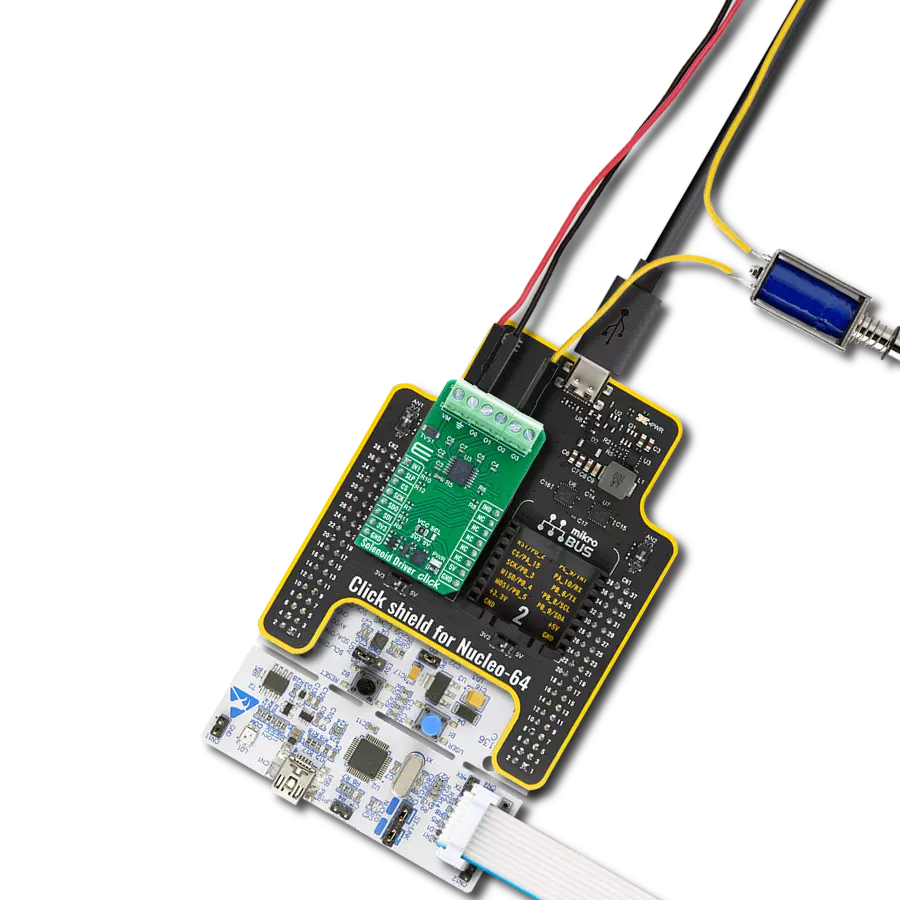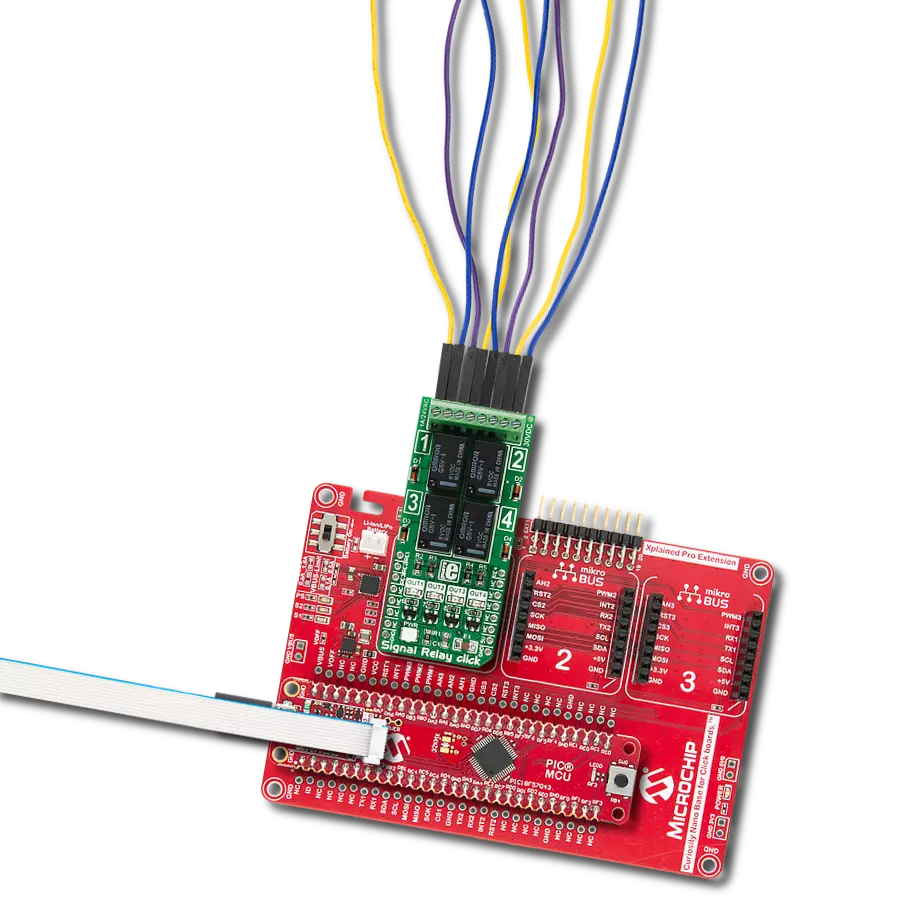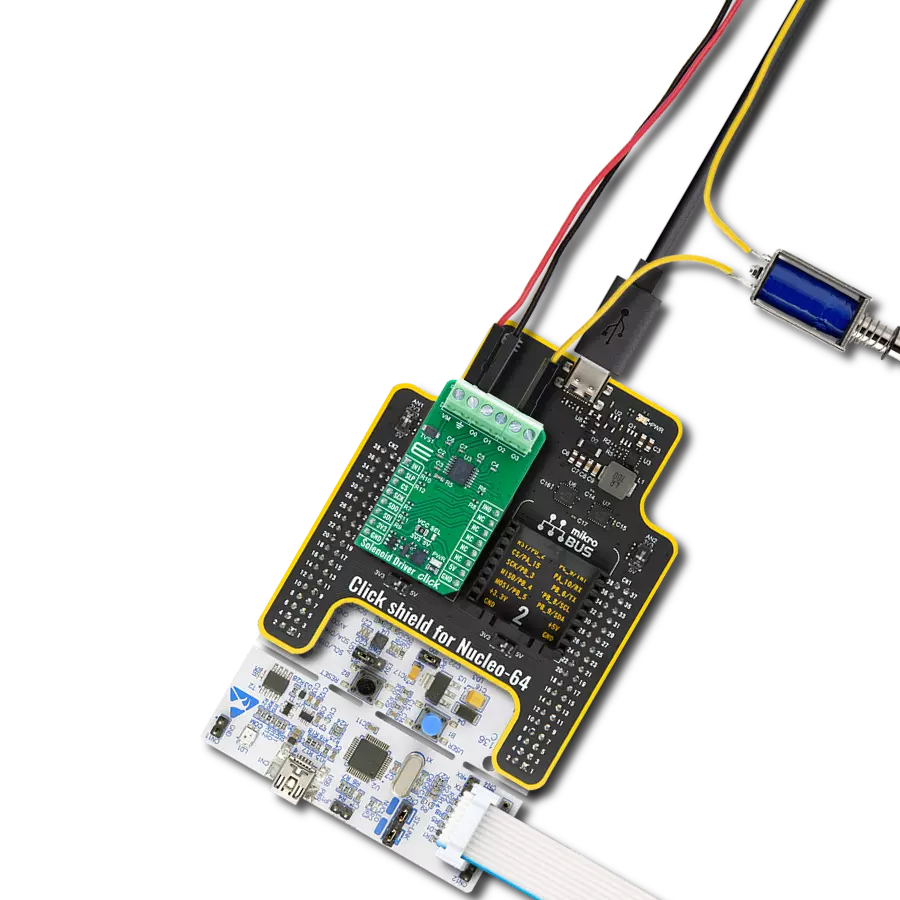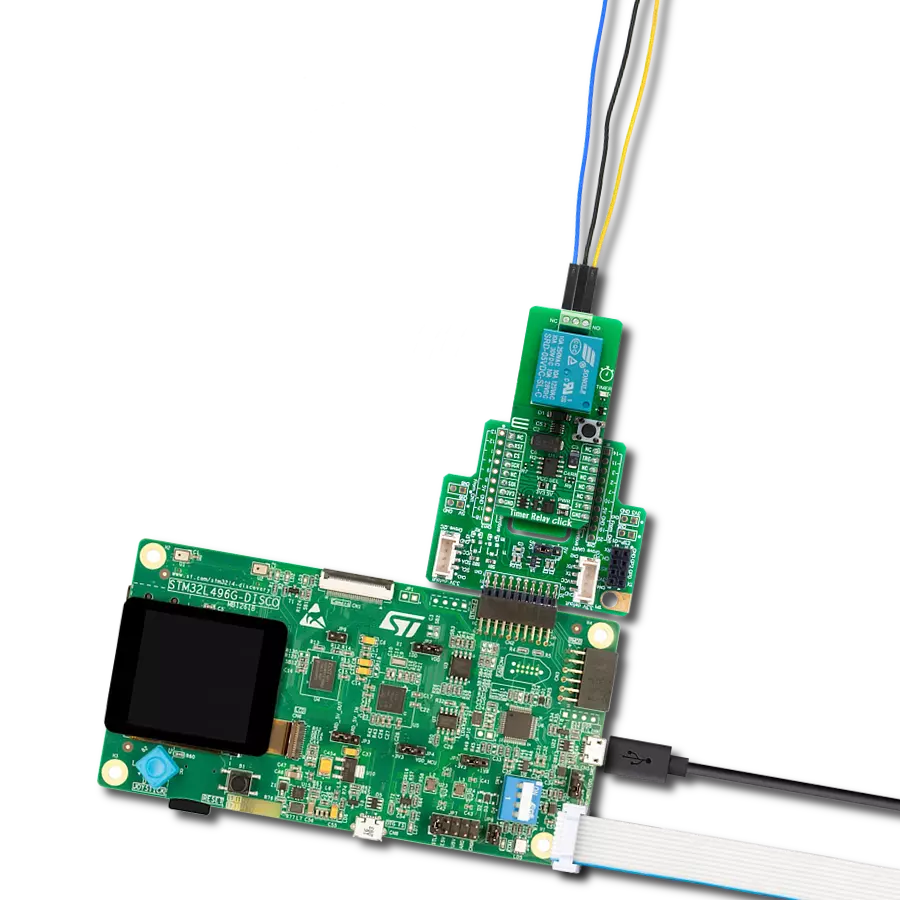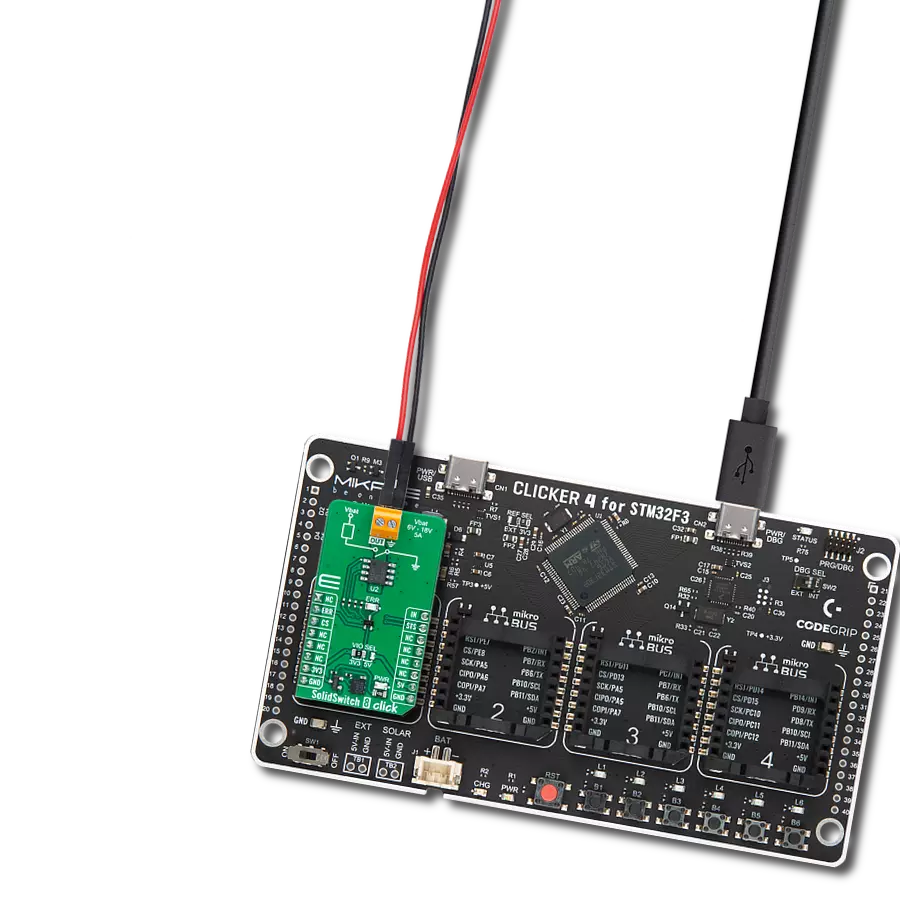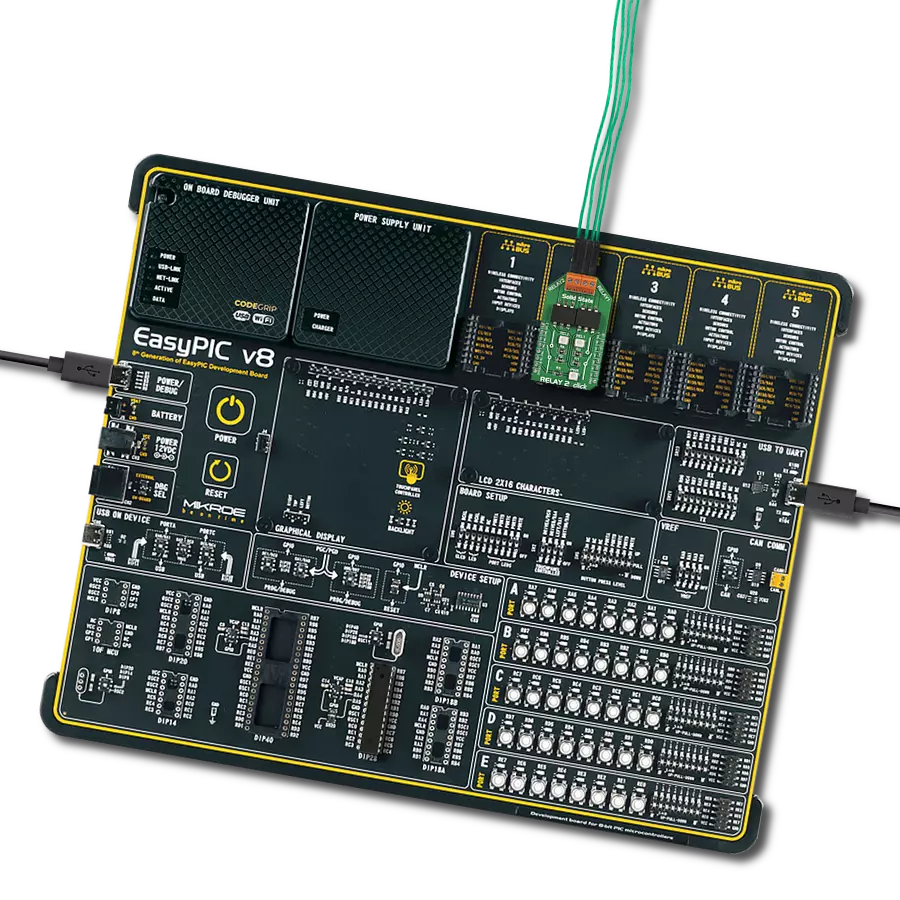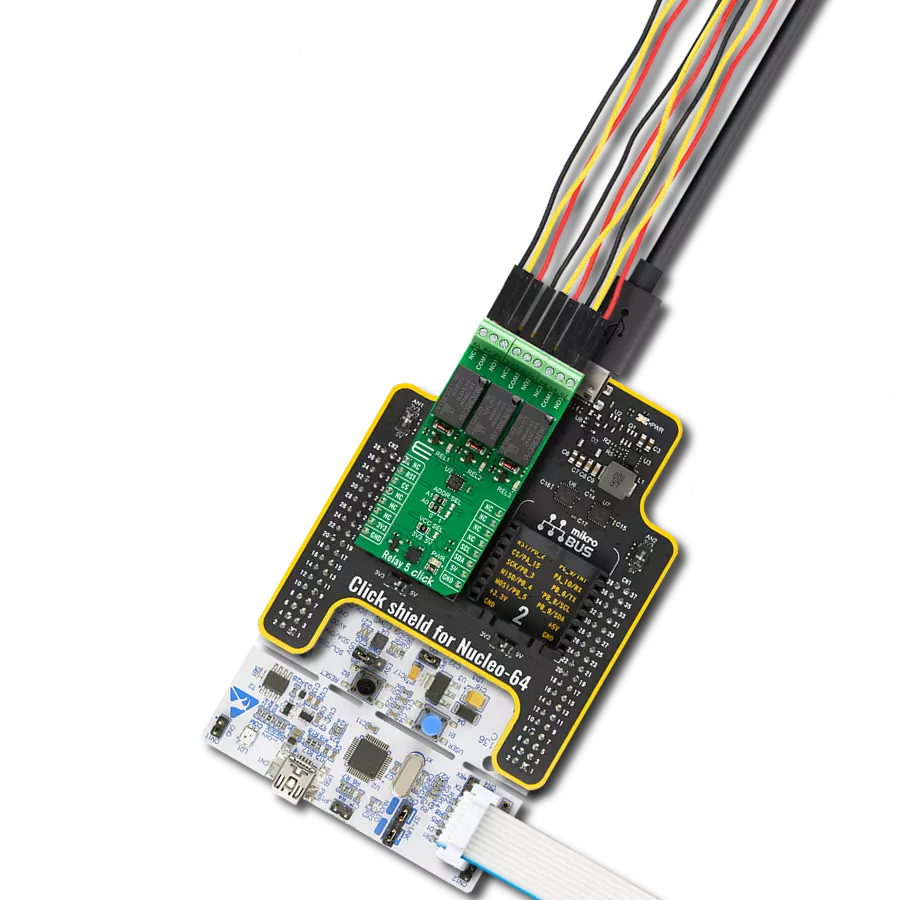Ensure safe and reliable load management in automotive power distribution systems
A
A
Hardware Overview
How does it work?
SolidSwitch 6 Click is based on the VNF1048F, a high-side switch controller for automotive applications from STMicroelectronics. This intelligent controller is designed to drive external MOSFETs in a high-side configuration, making it ideal for 12V, 24V, and 48V power distribution systems. Its key feature is intelligent e-fuse protection, which provides reliable overcurrent protection. It is crucial for automotive environments where safety and performance are paramount, like load management in cars, trucks, and other vehicles. The board operates with an external supply voltage ranging from 6V to 48V, allowing flexibility in power applications, with an integrated VIN green LED indicator showing an active external power supply. At its core, the VNF1048F replaces traditional high-current automotive fuses with an advanced overcurrent protection mechanism capable of detecting and responding to excessive current to protect connected systems. It features an
integrated gate drive that controls an external MOSFET (Q2 STL130N8F7) used for load control. The load connection is made through a VOUT terminal, accompanied by a green LED that indicates active load control. Additionally, SolidSwitch 6 Click integrates an NTC (Negative Temperature Coefficient) resistor, which monitors the external MOSFET's temperature to ensure safe operation. The VNF1048F offers protection features, including battery under-voltage shutdown, configurable external MOSFET desaturation shutdown, and hard short-circuit latch-off. It also protects the device and external MOSFET overheating, automatically shutting down in case of high temperatures. Despite its robust features, SolidSwitch 6 Click boasts a very low standby current, ensuring operation even in power-sensitive applications. The VNF1048F communicates with the host MCU via a 3.3V and 5V CMOS-compatible SPI interface, enabling system protection and
diagnostics. In addition to the SPI interface pins, this board also uses other mikroBUS™ socket pins, such as the DGN pin for diagnostic feedback and the HWL pin, which triggers a state where the registers are locked from writing, enhancing system security and prevent unintended configuration changes. The board also includes an unpopulated header labeled V3, which provides access to the output of the 3.3V internal LDO voltage regulator intended for logic and I/O supply. This Click board™ can operate with either 3.3V or 5V logic voltage levels selected via the VIO SEL jumper. This way, both 3.3V and 5V capable MCUs can use the communication lines properly. Also, this Click board™ comes equipped with a library containing easy-to-use functions and an example code that can be used as a reference for further development.
Features overview
Development board
Fusion for TIVA v8 is a development board specially designed for the needs of rapid development of embedded applications. It supports a wide range of microcontrollers, such as different 32-bit ARM® Cortex®-M based MCUs from Texas Instruments, regardless of their number of pins, and a broad set of unique functions, such as the first-ever embedded debugger/programmer over a WiFi network. The development board is well organized and designed so that the end-user has all the necessary elements, such as switches, buttons, indicators, connectors, and others, in one place. Thanks to innovative manufacturing technology, Fusion for TIVA v8 provides a fluid and immersive working experience, allowing access
anywhere and under any circumstances at any time. Each part of the Fusion for TIVA v8 development board contains the components necessary for the most efficient operation of the same board. An advanced integrated CODEGRIP programmer/debugger module offers many valuable programming/debugging options, including support for JTAG, SWD, and SWO Trace (Single Wire Output)), and seamless integration with the Mikroe software environment. Besides, it also includes a clean and regulated power supply module for the development board. It can use a wide range of external power sources, including a battery, an external 12V power supply, and a power source via the USB Type-C (USB-C) connector.
Communication options such as USB-UART, USB HOST/DEVICE, CAN (on the MCU card, if supported), and Ethernet is also included. In addition, it also has the well-established mikroBUS™ standard, a standardized socket for the MCU card (SiBRAIN standard), and two display options for the TFT board line of products and character-based LCD. Fusion for TIVA v8 is an integral part of the Mikroe ecosystem for rapid development. Natively supported by Mikroe software tools, it covers many aspects of prototyping and development thanks to a considerable number of different Click boards™ (over a thousand boards), the number of which is growing every day.
Microcontroller Overview
MCU Card / MCU
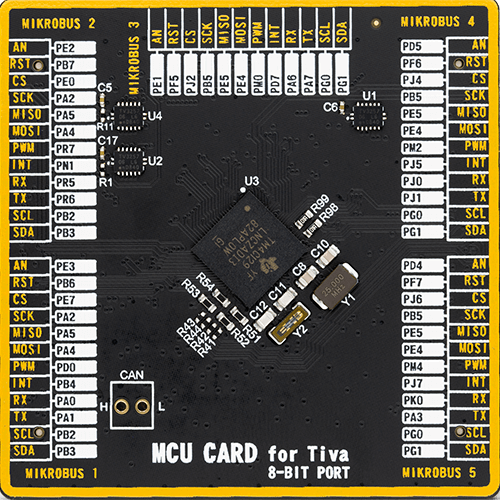
Type
8th Generation
Architecture
ARM Cortex-M4
MCU Memory (KB)
1024
Silicon Vendor
Texas Instruments
Pin count
212
RAM (Bytes)
262144
You complete me!
Accessories
Wire Jumpers Male to Male (15 cm length, 10pcs) is a set of high-quality jumper wires designed for easy prototyping and testing. Each wire in the set is 15cm long, with male connectors on both ends, allowing an easy connection between components on breadboards or other electronic projects. The set includes ten wires in different colors, providing clear identification and organization in your circuit. These wire jumpers are ideal for DIY projects, setups, and other electronic applications where quick, reliable connections are required.
Used MCU Pins
mikroBUS™ mapper
Take a closer look
Click board™ Schematic

Step by step
Project assembly
Track your results in real time
Application Output
1. Application Output - In Debug mode, the 'Application Output' window enables real-time data monitoring, offering direct insight into execution results. Ensure proper data display by configuring the environment correctly using the provided tutorial.

2. UART Terminal - Use the UART Terminal to monitor data transmission via a USB to UART converter, allowing direct communication between the Click board™ and your development system. Configure the baud rate and other serial settings according to your project's requirements to ensure proper functionality. For step-by-step setup instructions, refer to the provided tutorial.

3. Plot Output - The Plot feature offers a powerful way to visualize real-time sensor data, enabling trend analysis, debugging, and comparison of multiple data points. To set it up correctly, follow the provided tutorial, which includes a step-by-step example of using the Plot feature to display Click board™ readings. To use the Plot feature in your code, use the function: plot(*insert_graph_name*, variable_name);. This is a general format, and it is up to the user to replace 'insert_graph_name' with the actual graph name and 'variable_name' with the parameter to be displayed.

Software Support
Library Description
This library contains API for SolidSwitch 6 Click driver.
Key functions:
solidswitch6_get_vout- This function reads the raw ADC value and converts it to a proportional voltage level using the SPI serial interface.solidswitch6_set_control- This function writes control registers to configure the switch controller using the SPI serial interface.solidswitch6_get_device_temp- This function reads the raw ADC value and converts it to device temperature in degrees Celsius using the SPI serial interface.
Open Source
Code example
The complete application code and a ready-to-use project are available through the NECTO Studio Package Manager for direct installation in the NECTO Studio. The application code can also be found on the MIKROE GitHub account.
/*!
* @file main.c
* @brief SolidSwitch 6 Click example
*
* # Description
* This library contains API for the SolidSwitch 6 Click driver
* and demonstrate uses of the high-side switch controller with intelligent fuse protection.
*
* The demo application is composed of two sections :
*
* ## Application Init
* The initialization of the SPI module and log UART.
* After driver initialization, the app sets the default configuration.
*
* ## Application Task
* The demo application reads and displays the device temperature
* and voltage level of the current sense amplifier, NTC, and output voltage measurement.
* Results are being sent to the UART Terminal, where you can track their changes.
*
* @author Nenad Filipovic
*
*/
#include "board.h"
#include "log.h"
#include "solidswitch6.h"
static solidswitch6_t solidswitch6;
static log_t logger;
void application_init ( void )
{
log_cfg_t log_cfg; /**< Logger config object. */
solidswitch6_cfg_t solidswitch6_cfg; /**< Click config object. */
/**
* Logger initialization.
* Default baud rate: 115200
* Default log level: LOG_LEVEL_DEBUG
* @note If USB_UART_RX and USB_UART_TX
* are defined as HAL_PIN_NC, you will
* need to define them manually for log to work.
* See @b LOG_MAP_USB_UART macro definition for detailed explanation.
*/
LOG_MAP_USB_UART( log_cfg );
log_init( &logger, &log_cfg );
log_info( &logger, " Application Init " );
// Click initialization.
solidswitch6_cfg_setup( &solidswitch6_cfg );
SOLIDSWITCH6_MAP_MIKROBUS( solidswitch6_cfg, MIKROBUS_1 );
if ( SPI_MASTER_ERROR == solidswitch6_init( &solidswitch6, &solidswitch6_cfg ) )
{
log_error( &logger, " Communication init." );
for ( ; ; );
}
if ( SOLIDSWITCH6_ERROR == solidswitch6_default_cfg ( &solidswitch6 ) )
{
log_error( &logger, " Default configuration." );
for ( ; ; );
}
log_info( &logger, " Application Task " );
log_printf( &logger, " ______________________\r\n" );
Delay_ms ( 100 );
}
void application_task ( void )
{
float app_buf = 0;
if ( SOLIDSWITCH6_OK == solidswitch6_get_device_temp( &solidswitch6, &app_buf ) )
{
log_printf( &logger, " Temperature: %.2f [degC]\r\n", app_buf );
Delay_ms ( 100 );
}
if ( SOLIDSWITCH6_OK == solidswitch6_get_vntc( &solidswitch6, &app_buf ) )
{
log_printf( &logger, " NTC: %.2f V\r\n", app_buf );
Delay_ms ( 100 );
}
if ( SOLIDSWITCH6_OK == solidswitch6_get_vout( &solidswitch6, &app_buf ) )
{
log_printf( &logger, " Vout: %.2f V\r\n", app_buf );
Delay_ms ( 100 );
}
if ( SOLIDSWITCH6_OK == solidswitch6_get_vds( &solidswitch6, &app_buf ) )
{
log_printf( &logger, " VDS: %.2f V\r\n", app_buf );
Delay_ms ( 100 );
}
log_printf( &logger, " ______________________\r\n" );
Delay_ms ( 1000 );
}
int main ( void )
{
/* Do not remove this line or clock might not be set correctly. */
#ifdef PREINIT_SUPPORTED
preinit();
#endif
application_init( );
for ( ; ; )
{
application_task( );
}
return 0;
}
// ------------------------------------------------------------------------ END
Additional Support
Resources
Category:Relay





















